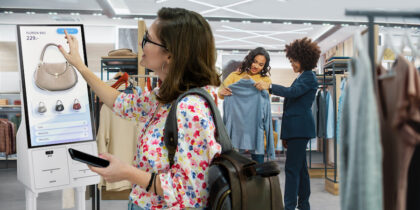As customer-centric retailing, and the technologies delivering it, continue to grow in significance, a plethora of new solutions claim to fortify a retailer’s customer engagement program.
However, while many retail executives consider it critical to master the customer experience, not all achieve strong results from their customer engagement initiatives. Which of the growing range of technology offerings best invigorate the in-store shopping experience? Which generate the greatest returns on a customer experience investment, and what defines the approach to a winning customer engagement program?
The Crucial Role of Digital
Customer experience leaders recognize the critical role digital technologies play in delivering the experiences customers value and demand, according to Accenture. Organizations classified as “Leaders” by Accenture are convinced that digital investments provide a competitive advantage, as they “allocate a larger portion of their customer experience budget to technology-enabled customer experiences.” In fact, many leaders strongly agree that digital channels and technologies significantly improve customer interactions, provide new sources of revenue, engage employees and partners more effectively, grow revenues and reduce costs. By far, the fastest growing investment area is in smart and intelligent devices, with 48 percent of leaders spending significantly more in this area than in the last two years.
According to the Boston Consulting Group, brick-and-mortar retailers embracing digital technologies to enhance the customer experience and improve employee performance “tend to outperform retailers that have not yet implemented a digital strategy.” Furthermore, in a survey of 25 fashion retailers, leaders of in-store digital implementations showed stronger growth in earnings before interest and tax (EBIT) than digital followers.
In-store digital solutions are transforming the customer shopping experience. BCG points to “in-store touch screens that provide customers with ‘endless aisles’ (that is, the full range of available products); ‘magic mirrors’ that offer product information, recommendations and virtual fittings; and ‘clienteling’ (an approach by which well-informed store staff using data on individual customers’ preferences and buying habits create a customized in-store experience).”
Smartphones, mobile wallets, tablets, wearable technologies, radio-frequency identification (RFID), bar code scanning and digital signage (both in-store and outdoors) to draw customers through the door are also among the popular digital solutions delivering today’s most valuable customer engagement programs and in-store shopping experiences.
Connectivity
As digital technologies continue to influence shopping journeys and in-store buying decisions, retailers should establish solid information platforms for improving and building on stellar customer experiences. Retail innovations will continue to accelerate, and the customer experience strategy and supporting infrastructure needs to accommodate the increasing range of digital resources, especially as third-party content providers keep launching inventive, specialized improvements and operational alternatives.
Thus, the key to a strategic infrastructure investment is connectivity. The smartest retail technology deployments are those that combine solutions from numerous software vendors to meld together in the digital store framework. New and existing in-store devices and related software integrate and communicate seamlessly, which is particularly important in an increasingly mobile retail environment. From smart furniture, readers, mobile point-of-sale technologies, biometric identification and customer tracking to beacons, kiosks, customer relationship management software and multicurrency business management systems, connectivity means easy, secure and cost-efficient implementation of customer experience accelerators.
Ensuring Return on Investment
While there are many options, budgets are tight and some leaders hesitate to invest what’s required to deliver on their customer experience strategy and its supporting customer engagement program.
With this in mind, scalability is a key customer experience investment strategy. The customer experience executive hoping to bring groundbreaking technology into the retail organization can assess and demonstrate ROI with scalable solutions that transfer easily from a store pilot to an eventual chain-wide implementation. Technology companies working with third-party content providers offer the most flexibility in scale and efficiency. These solutions are targeted, nimble and quick to assess, both operationally and financially.
In addition, Accenture found that customer experience leaders “pick investments selectively, with confidence in ROI, instead of taking a scattershot approach to allocating resources.” Leaders continue to refine key strategic and execution capabilities and generate revenue growth, as opposed to reducing costs and attempting to catch up with peers. Furthermore, across the board, Accenture found that customer experience leaders generate outsized returns on their customer experience investments.
Leaders consistently create compelling experiences to keep pace with customers’ changing behaviors and needs, and these differentiating customer experiences are how executives can drive their companies’ growth.
Learn more about the technology solutions supporting the evolution of the customer experience.







